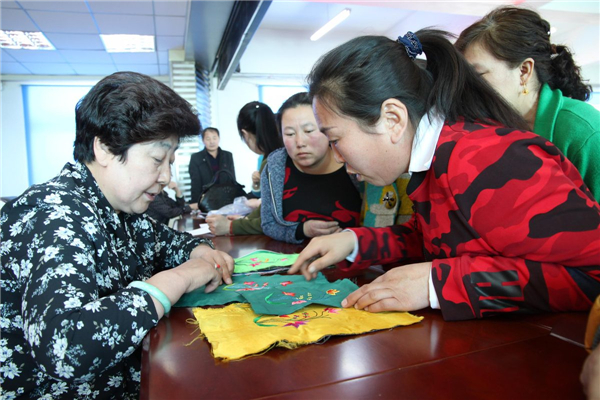Matriarch stitches together precise plan to end poverty

Bai Jingying (left) teaches villagers embroidery in the Horqin Right Wing Middle Banner, Inner Mongolia autonomous region, in 2017. CHINA DAILY
Traditional embroidery improves rural women's incomes and living standards.
When China announced the eradication of extreme poverty in February, the landmark achievement impressed the entire world. In one remote region in the country's north, this was done with nimble fingers, the determination of one woman and a handicraft once deemed only fit for nobility.
Residents from Horqin Right Wing Middle Banner in the Inner Mongolia autonomous region made the miracle happen through traditional Wangfu embroidery.
As a county-level settlement, the banner government has opened embroidery classes for poverty-stricken women to learn how to decorate clothes, slippers and pillowcases with traditional designs.
Bai Jingying, an inheritor of the Wangfu embroidery tradition, initiated the industry-driven poverty alleviation campaign. The initiative encourages residents, especially rural women, to generate more income by developing their manual skills.
Originating in the Qing Dynasty (1644-1911), Wangfu embroidery was once only worn by nobility who resided in the royal palace. In 2009, the traditional Mongolian handicraft from the banner was added to the region's list of intangible cultural heritage.
Located in the southern foothills of the Greater Hinggan Mountains, the banner was once the most impoverished area in Inner Mongolia. It had to overcome great challenges to eradicate poverty due to poor public transportation and a lack of industries.
Bai started learning embroidery from her mother at the age of 7. Her interest in the craft was aroused, and she later decided to teach women embroidery by holding free training classes in various counties.
Among the skills she imparted were embroidery, pattern designs and color collocation.
In 2016, Bai initiated a workshop co-managed by the local University Graduates Employment and Startups Association and the Xiangrui Embroidery Poverty Alleviation Service Company.
Over the past four years, Bai has inspired 26,000 women to participate in the embroidery industry, and helped 2,895 poor families increase their per capita income by 2,000 yuan ($310) every year.
"We have also developed more tourism products with folk characteristics and provided tailor-made solutions for poverty alleviation," said Bai, who is chairwoman of the standing committee of the banner's people's congress.
The University Graduates Employment and Startups Association, in charge of both online and offline sales, helps sell robes, pillowcases, slippers and other household products with exquisite traditional Mongolian embroidery both home and abroad.
Yang Fulin, the chairman of the association, said: "We have created more than 200 types of self-designed products, such as Mongolian robes, back cushions, pen containers, bags and shoes. In the future, we are going to design more products with local cultural elements."
Online shops and brick-and-mortar stores in Ulaanhot, Hohhot and other cities in the region carry their products, Yang said. About 150 to 200 pairs of slippers can be sold in all those outlets every day and each pair earns the maker about 60 yuan.
In February, Bai came to Beijing to participate in a national commendation conference at the Great Hall of the People, during which she was honored as one of the country's 10 role models for her contributions to poverty alleviation.
At the conference, President Xi Jinping, also general secretary of the Communist Party of China Central Committee, presented her with the award.
Bai said that standing by the side of the president was the greatest honor and happiest moment of her life.
"We live in a county that used to be poor. I have a responsibility to find ways to help people out of poverty," she said. "I am proud of my participation in the anti-poverty fight. I will continue guiding women to develop the embroidery industry and contribute to the revitalization of rural areas."



 Print
Print Mail
Mail


